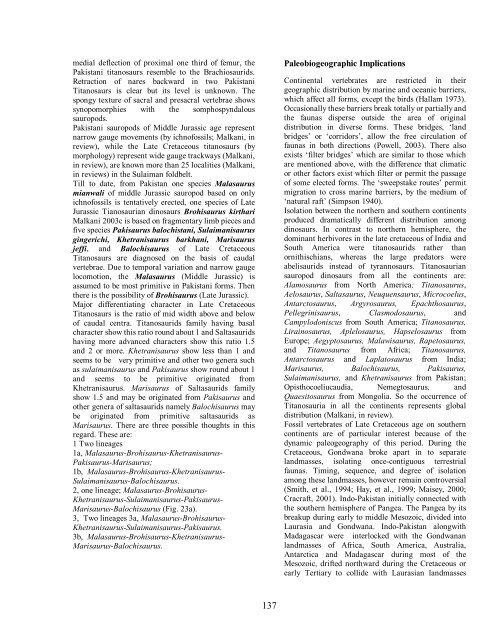Download pdf - Geological Survey of Pakistan
Download pdf - Geological Survey of Pakistan
Download pdf - Geological Survey of Pakistan
Create successful ePaper yourself
Turn your PDF publications into a flip-book with our unique Google optimized e-Paper software.
medial deflection <strong>of</strong> proximal one third <strong>of</strong> femur, the<br />
<strong>Pakistan</strong>i titanosaurs resemble to the Brachiosaurids.<br />
Retraction <strong>of</strong> nares backward in two <strong>Pakistan</strong>i<br />
Titanosaurs is clear but its level is unknown. The<br />
spongy texture <strong>of</strong> sacral and presacral vertebrae shows<br />
synopomorphies with the somphospyndalous<br />
sauropods.<br />
<strong>Pakistan</strong>i sauropods <strong>of</strong> Middle Jurassic age represent<br />
narrow gauge movements (by ichn<strong>of</strong>ossils; Malkani, in<br />
review), while the Late Cretaceous titanosaurs (by<br />
morphology) represent wide gauge trackways (Malkani,<br />
in review), are known more than 25 localities (Malkani,<br />
in reviews) in the Sulaiman foldbelt.<br />
Till to date, from <strong>Pakistan</strong> one species Malasaurus<br />
mianwali <strong>of</strong> middle Jurassic sauropod based on only<br />
ichn<strong>of</strong>ossils is tentatively erected, one species <strong>of</strong> Late<br />
Jurassic Tianosaurian dinosaurs Brohisaurus kirthari<br />
Malkani 2003c is based on fragmentary limb pieces and<br />
five species Pakisaurus balochistani, Sulaimanisaurus<br />
gingerichi, Khetranisaurus barkhani, Marisaurus<br />
jeffi, and Balochisaurus <strong>of</strong> Late Cretaceous<br />
Titanosaurs are diagnosed on the basis <strong>of</strong> caudal<br />
vertebrae. Due to temporal variation and narrow gauge<br />
locomotion, the Malasaurus (Middle Jurassic) is<br />
assumed to be most primitive in <strong>Pakistan</strong>i forms. Then<br />
there is the possibility <strong>of</strong> Brohisaurus (Late Jurassic).<br />
Major differentiating character in Late Cretaceous<br />
Titanosaurs is the ratio <strong>of</strong> mid width above and below<br />
<strong>of</strong> caudal centra. Titanosaurids family having basal<br />
character show this ratio round about 1 and Saltasaurids<br />
having more advanced characters show this ratio 1.5<br />
and 2 or more. Khetranisaurus show less than 1 and<br />
seems to be very primitive and other two genera such<br />
as sulaimanisaurus and Pakisaurus show round about 1<br />
and seems to be primitive originated from<br />
Khetranisaurus. Marisaurus <strong>of</strong> Saltasaurids family<br />
show 1.5 and may be originated from Pakisaurus and<br />
other genera <strong>of</strong> saltasaurids namely Balochisaurus may<br />
be originated from primitive saltasaurids as<br />
Marisaurus. There are three possible thoughts in this<br />
regard. These are:<br />
1 Two lineages<br />
1a, Malasaurus-Brohisaurus-Khetranisaurus-<br />
Pakisaurus-Marisaurus;<br />
1b, Malasaurus-Brohisaurus-Khetranisaurus-<br />
Sulaimanisaurus-Balochisaurus.<br />
2, one lineage; Malasaurus-Brohisaurus-<br />
Khetranisaurus-Sulaimanisaurus-Pakisaurus-<br />
Marisaurus-Balochisaurus (Fig. 23a).<br />
3, Two lineages 3a, Malasaurus-Brohisaurus-<br />
Khetranisaurus-Sulaimanisaurus-Pakisaurus.<br />
3b, Malasaurus-Brohisaurus-Khetranisaurus-<br />
Marisaurus-Balochisaurus.<br />
137<br />
Paleobiogeographic Implications<br />
Continental vertebrates are restricted in their<br />
geographic distribution by marine and oceanic barriers,<br />
which affect all forms, except the birds (Hallam 1973).<br />
Occasionally these barriers break totally or partially and<br />
the faunas disperse outside the area <strong>of</strong> original<br />
distribution in diverse forms. These bridges, ‘land<br />
bridges’ or ‘corridors’, allow the free circulation <strong>of</strong><br />
faunas in both directions (Powell, 2003). There also<br />
exists ‘filter bridges’ which are similar to those which<br />
are mentioned above, with the difference that climatic<br />
or other factors exist which filter or permit the passage<br />
<strong>of</strong> some elected forms. The ‘sweepstake routes’ permit<br />
migration to cross marine barriers, by the medium <strong>of</strong><br />
‘natural raft’ (Simpson 1940).<br />
Isolation between the northern and southern continents<br />
produced dramatically different distribution among<br />
dinosaurs. In contrast to northern hemisphere, the<br />
dominant herbivores in the late cretaceous <strong>of</strong> India and<br />
South America were titanosaurids rather than<br />
ornithischians, whereas the large predators were<br />
abelisaurids instead <strong>of</strong> tyrannosaurs. Titanosaurian<br />
sauropod dinosaurs from all the continents are:<br />
Alamosaurus from North America; Titanosaurus,<br />
Aelosaurus, Saltasaurus, Neuquensaurus, Microcoelus,<br />
Antarctosaurus, Argyrosaurus, Epachthosaurus,<br />
Pellegrinisaurus, Clasmodosaurus, and<br />
Campylodoniscus from South America; Titanosaurus,<br />
Lirainosaurus, Aplelosaurus, Hapselosaurus from<br />
Europe; Aegyptosaurus, Malawisaurus, Rapetosaurus,<br />
and Titanosaurus from Africa; Titanosaurus,<br />
Antarctosaurus and Laplatosaurus from India;<br />
Marisaurus, Balochisaurus, Pakisaurus,<br />
Sulaimanisaurus, and Khetranisaurus from <strong>Pakistan</strong>;<br />
Opisthocoeliucaudia, Nemegtosaurus, and<br />
Quaesitosaurus from Mongolia. So the occurrence <strong>of</strong><br />
Titanosauria in all the continents represents global<br />
distribution (Malkani, in review).<br />
Fossil vertebrates <strong>of</strong> Late Cretaceous age on southern<br />
continents are <strong>of</strong> particular interest because <strong>of</strong> the<br />
dynamic paleogeography <strong>of</strong> this period. During the<br />
Cretaceous, Gondwana broke apart in to separate<br />
landmasses, isolating once-contiguous terrestrial<br />
faunas. Timing, sequence, and degree <strong>of</strong> isolation<br />
among these landmasses, however remain controversial<br />
(Smith, et al., 1994; Hay, et al., 1999; Maisey, 2000;<br />
Cracraft, 2001). Indo-<strong>Pakistan</strong> initially connected with<br />
the southern hemisphere <strong>of</strong> Pangea. The Pangea by its<br />
breakup during early to middle Mesozoic, divided into<br />
Laurasia and Gondwana. Indo-<strong>Pakistan</strong> alongwith<br />
Madagascar were interlocked with the Gondwanan<br />
landmasses <strong>of</strong> Africa, South America, Australia,<br />
Antarctica and Madagascar during most <strong>of</strong> the<br />
Mesozoic, drifted northward during the Cretaceous or<br />
early Tertiary to collide with Laurasian landmasses


